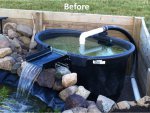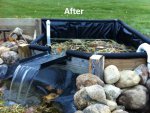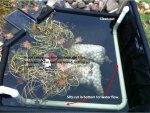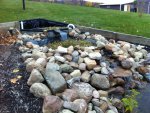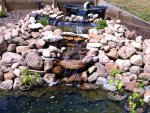Like I said in the quoted text,,,"
If you want it to be a settlement tank bog is better".
A bog, as defined in this forum, is primarily a settlement tank. A big round or rectangular structure filled with gravel. Water enters one end and makes its way thru the gravel and exits the opposite end.
The water volume can't all take the shortest path to the outflow because it's no longer the
path of least resistance as the spaces between gravel pebbles are too small for all the water volume. So the water is forced to spread out. Spreading out water flow has the effect of slowing water flow. Slower water = settlement. The process is called
particle aggregation.
I know many people in this forum despise science, laws of physics, etc, and instead prefer to use their imagination to create a world they like better. But if you're serious about making a functional filter I think it's best to stick with the laws of physics. Leave the pretending to people who build filters as an affectation.
For example, some people choose to add distribution pipes at the bottom of bogs thinking they are somehow "improving" the filter. But it decreases filter performance to a large degree. Water goes fast down the pipe, past most of the filter, and exits the pipe as close to the outflow as possible, and then a fairly short path up thru the gravel so less chance of settlement (particle aggregation) . It's also less chance for any bio filtering, although bogs are already such poor bio filters that the loss isn't much to worry about. Losing 80% of almost nothing is still almost nothing.
Adding an open space beneath the gravel can be as bad or worst than the distribution pipe deal. If the open space were the proper size for a settlement tank (and this can be calculated) then sure, the open space would work as a settlement chamber. The gravel above would have very little effect. The settlement chamber would work basically the same whether the gravel was there or not. However, the cost of the grate would be enormous given the size settlement tanks have to be (bigger than your pond).
If the opening is undersized you'd have the exact same issues as any undersized tank. More water movement than you had in the pond and particles are less likely to fall out of suspension.
Settlement tanks in serious ponds are normally are filled with brushes. The idea is to get the water to spread out, slow down, but also create lots of little
eddies which create faster and slower currents, like in a meandering stream which "
inner part of the river has less energy and deposits what it is carrying". This allows the settlement tank to be smaller than the pond and still settle out some particles. Just a plain big tank, without brushes, the tank has to be larger than the pond. Otherwise water in the pond will be moving slower than the tank and the pond would be the more effective settlement tank.
Most vortex filters used the same basic idea, but were even less effective than brushes.
Settlement will happen in any size tank, even in a 55 gal drum there will be some settlement. I've read many posts of people with tiny tanks they call settlement tanks and say "works great because when I drain it dirt comes out". Any thing can be called a settlement tank. What I'm talking about is efficiency. I'm on a diet where I eat one less jellybean per year. Yes, that is a "diet", but not too effective. I'd say I was kidding myself. Creating a fantasy world I wanted to live in.
Settlement tanks were once state of the art, but much better methods were found so you don't see settlement tanks being added very often these days to new, serious, ponds.
The reason brushes are used is because they're easy to remove and clean. In serious ponds I've seen online (mostly far east) the entire tank is dumped and hosed down every few days.
Brushes are expensive, gravel is cheap.
Gravel serves the same function as the brushes,but even better imo. The downside is it isn't as easy to remove. Not being able to clean a bog is not an issue for low fish load water gardens where water quality isn't a big issue. And bogs work as a darn good settlement tank for 2,3,5, maybe even 10 years. Just like any settlement tank short term crap accumulates and so you don't see it in the pond water, so water is more clear. But as that crap decomposes it will eventually become such small particles (DOCs) that it will no longer stay in the bog or settlement tank. Now I know some bog owners claim to not have any DOCs, but that is 100% pure fantasy and a complete lack of understanding of the must basic pond functions
However, DOCs can be dealt with other ways, like water changes and
foam fractionation. But then you kind of have to ask yourself, if I'm having to do water changes to remove waste why not just do that from day one? And why do I need to add a second filter to clean up the mess produced by the bog? That's why bogs aren't used on serious ponds.
When I say "serious pond" I mean several things, expensive to build, expensive fish, higher fish load, owners really into the hobby and expect to have the pond for the rest of their lives. I don't know another term to say that. Maybe "more serious" would be better?
While bog's aren't the best filters on the planet I think they'd perfect filters for many, many ponds. Most pond owners are never going to clean filters no matter how easy it is. Even emptying skimmer baskets can be a chore for many people. That's the biggest advantage to a bog, set it and forget it. You can get several years of trouble free use. And for most of these types of ponds they're gong to be filled in before too long anyways for other reasons. Every pond has different needs, every owner different goals. Even if a person wants to believe distribution pipes are great I say that's reason enough to add them. If it makes you happy, do it, if the purpose of the pond is to fill that desire. If the desire is instead having good water quality etc, then filters have to be looked at in a more serious manner to achieve that goal.
Bead filter
An open space beneath the gravel would basically be a bead filter. It's a tank and the beads float. So water has to find it's way thru the beads, slows down, drops waste. But the waste doesn't then fall back down thru the beads into the void below. It stays in the beads. The gravel would work the same way.
In the bead filter the void below is not a settlement area. They just need the extra space during the cleaning cycle where the beads are mixed and "washed" off and the dirty water drained away.
Bead filters where once state of the art and were considered to be the Holy Grail of filters in that they could do both bio and mechanical in one process. But that turned out not to be true. Like all combo filters before it and since, it did neither very well.
With gravel instead of beads cleaning wouldn't be reasonable.
Bottom line
I don't see any upside to creating a void below the gravel. And it would be extremely expensive.

